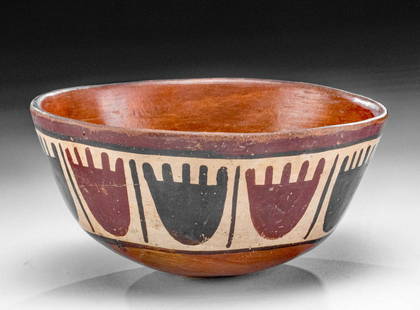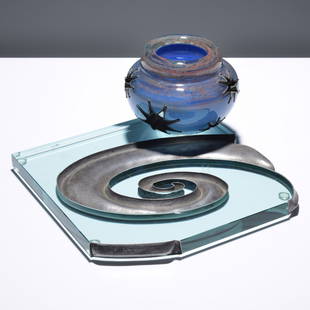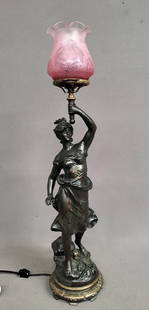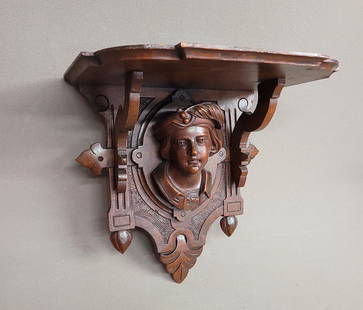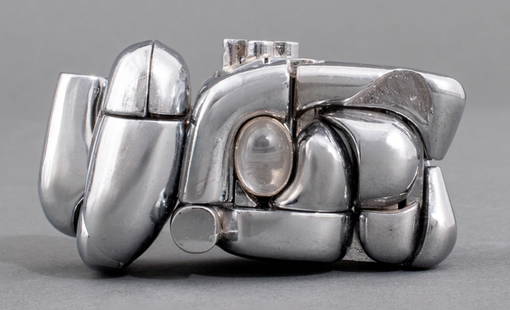
Cocle Polychrome Pedestal Bowl w/ Abstract Zoomorph
Similar Sale History
View More Items in Sculptures & CarvingsRelated Sculptures & Carvings
More Items in Sculptures & Carvings
View MoreRecommended Art
View More







Item Details
Description
Pre-Columbian, Central America, Panama, Gran Cocle, Macaracas type, ca. 800 to 1000 CE. A stylish and expertly detailed pottery bowl bearing a polychrome rendition of an abstract creature within the deep basin. The vessel presents with a hemispherical body resting atop a flared, hollow foot and has a smoothed, angular rim surrounding the exterior of the bowl. The basin exhibits a cream-hued ground that is embellished with a monstrous serpentine creature bearing a curvilinear body lined with hooked barbs, attenuated arms with lengthy claws, and a rectangular head with discoid eyes, a downturned mouth, and enormous antennae, all decorated in characteristic hues of black, brick-red, and purple. High burnishing marks within the basin and the bowl exterior create a pleasingly smooth tactile experience, and the surfaces of the foot are unburnished and coarse to the touch. A marvelous example of fine Cocle artistry! Size: 10.3" W x 5.25" H (26.2 cm x 13.3 cm)
According to scholar Samuel Kirkland Lothrop, "The Gran Cocle culture is a Pre-Columbian archaeological culture that gets its name from the area from which it was based, the now present-day Cocle province of Panama. The Gran Cocle term applies to a loosely studied group of Native American sub-cultures in this region, identified by their pottery styles. The overall period spans a time from 150 B.C. to the end in the 16th century A.D. upon Spanish contact. The most ancient culture is the La Mula period from 150 B.C. to 300 A.D. The La Mula and later Monagrillo and Tonosi pottery styles are identified by their use of three paint colors which were black, red and white (or cream). The later Cubita style saw the emergence of the use of four colors. The styles of Conte, Macaracas and Joaquín added purple to their palette and this hue ranged from grayish tones to red purple. The use of purple disappeared in the subsequent styles of Parita and El Altillo and the paint style reverted to the use of three colors. Most notable in the artistic renderings are the overt use of geometric designs." (For more information, see Armand Labbe, "Guardians of The Life Stream: Shamans, Art and Power in Prehispanic Central Panama." Bowers Museum of Cultural Art, University of Washington Press, 1995)
Provenance: ex-Stein collection, Bloomfield Hills, Michigan, USA, acquired prior to 2010; ex-William Micol collection, Milford, Michigan, USA
All items legal to buy/sell under U.S. Statute covering cultural patrimony Code 2600, CHAPTER 14, and are guaranteed to be as described or your money back.
A Certificate of Authenticity will accompany all winning bids.
We ship worldwide to most countries and handle all shipping in-house for your convenience.
#164270
According to scholar Samuel Kirkland Lothrop, "The Gran Cocle culture is a Pre-Columbian archaeological culture that gets its name from the area from which it was based, the now present-day Cocle province of Panama. The Gran Cocle term applies to a loosely studied group of Native American sub-cultures in this region, identified by their pottery styles. The overall period spans a time from 150 B.C. to the end in the 16th century A.D. upon Spanish contact. The most ancient culture is the La Mula period from 150 B.C. to 300 A.D. The La Mula and later Monagrillo and Tonosi pottery styles are identified by their use of three paint colors which were black, red and white (or cream). The later Cubita style saw the emergence of the use of four colors. The styles of Conte, Macaracas and Joaquín added purple to their palette and this hue ranged from grayish tones to red purple. The use of purple disappeared in the subsequent styles of Parita and El Altillo and the paint style reverted to the use of three colors. Most notable in the artistic renderings are the overt use of geometric designs." (For more information, see Armand Labbe, "Guardians of The Life Stream: Shamans, Art and Power in Prehispanic Central Panama." Bowers Museum of Cultural Art, University of Washington Press, 1995)
Provenance: ex-Stein collection, Bloomfield Hills, Michigan, USA, acquired prior to 2010; ex-William Micol collection, Milford, Michigan, USA
All items legal to buy/sell under U.S. Statute covering cultural patrimony Code 2600, CHAPTER 14, and are guaranteed to be as described or your money back.
A Certificate of Authenticity will accompany all winning bids.
We ship worldwide to most countries and handle all shipping in-house for your convenience.
#164270
Condition
Foot reattached to body and may perhaps be from a different vessel, with resurfacing and light adhesive residue along break lines. One stable hairline fissure running vertically on foot. Bowl body has light abrasions to exterior surfaces and basin pigment. Nice root marks inside basin, light manganese deposits on bowl exterior, and great preservation to pigment within basin.
Buyer's Premium
- 24.5%
Cocle Polychrome Pedestal Bowl w/ Abstract Zoomorph
Estimate $2,400 - $3,600
14 bidders are watching this item.
Shipping & Pickup Options
Item located in Louisville, CO, usOffers In-House Shipping
Local Pickup Available
Payment

Related Searches
TOP































